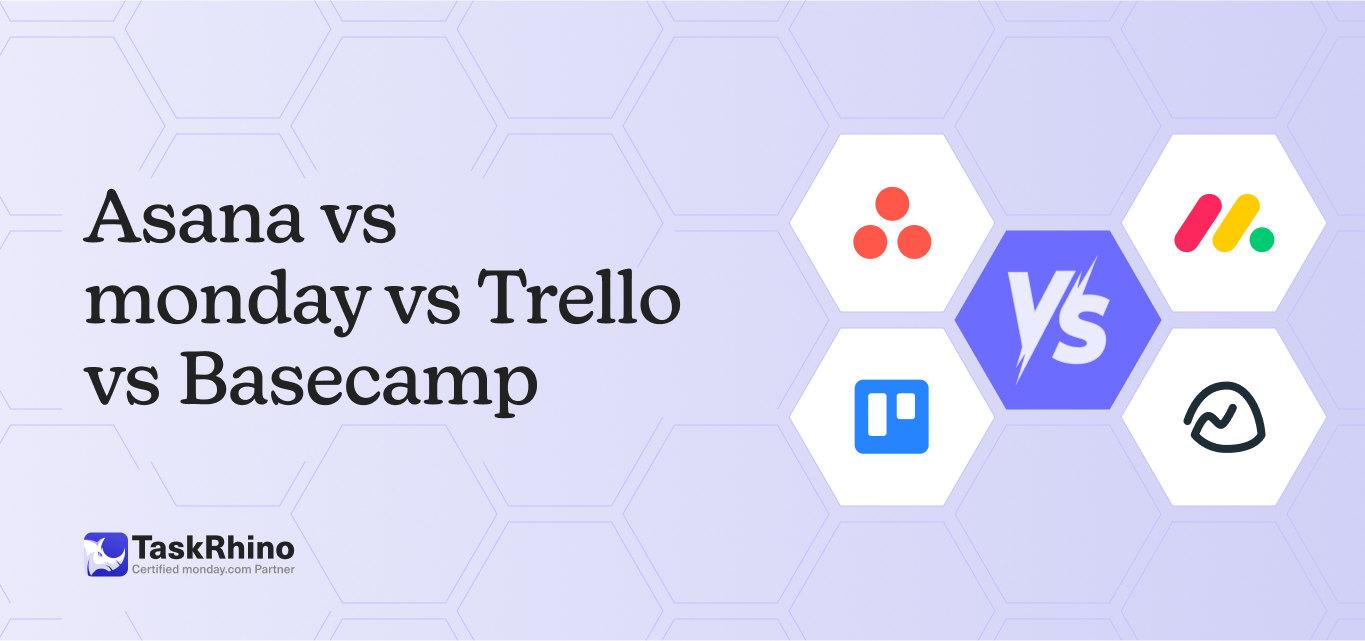
Asana vs Monday vs Trello vs Basecamp: Complete 2025 Comparison Guide
Summary: This blog compares Asana, monday.com, Trello, and Basecamp, highlighting key features, pros, and cons. A detailed table and six key points break down what each tool offers, helping you find your team’s best project management solution.
If you’ve ever felt like managing a project is more stressful than it needs to be, you’re not using the best one of all.
Let us burst the bubble— the right project management software can take the chaos out of the process.
In this blog, we’re comparing four top tools—Asana, monday.com, Basecamp, and Trello. We’ll dive into how each of them works, what they do best what are the drawbacks for your project, and which one could make your team’s work life easier.
With the right insights, you can choose a tool that not only streamlines your projects but also boosts collaboration and productivity within your team.
Continue reading more about finding the tool that saves you more productive time, resources, and headaches.
Also, We’ve compared each one individually with monday.com, examining functionality, user experience, and overall effectiveness.
Such as monday.com vs Asana, Trello vs monday.com, and Basecamp vs monday.com
How We Conducted a Thorough Review of Both Platforms?
To thoroughly review Asana, monday.com, Trello, and Basecamp, we analyzed each platform’s core features, usability, and pricing. We compared their project management tools and collaboration features. We also considered user feedback from G2, Capterra, and Reddit to ensure a well-rounded perspective, providing a more transparent evaluation of each tool’s strengths and limitations.
What is Asana?
Asana is a popular project management tool that helps teams plan, organize, and track their work. Known for its user-friendly interface, Asana excels at task management and is particularly adept at handling task dependencies, which is necessary for managing complex projects.
Asana offers multiple views, such as Kanban boards, lists, and timelines, allowing teams to stay organized and visualize project progress. It integrates with tools like Microsoft Teams, making it a versatile choice for team collaboration.
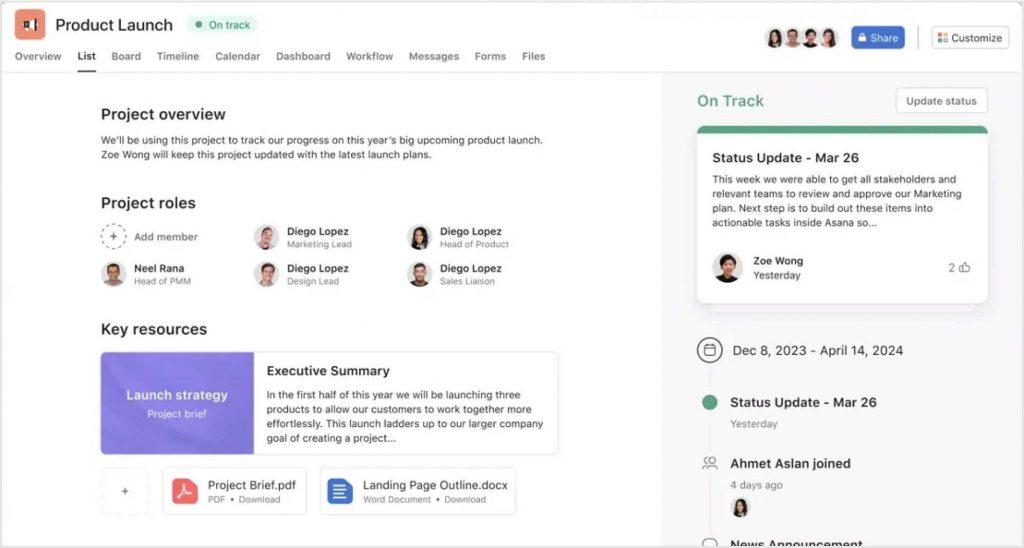
While Asana offers a free version, it has limited features, such as a need for advanced reporting tools, restricted integrations, and a cap on the number of tasks and projects you can manage.
Also, premium options, such as time tracking, automation features, and project templates, are only available in paid plans, making the free plan more suitable for smaller teams.
Overall, Asana is ideal for teams looking for structured task management focusing on task dependencies, though larger teams might require an upgrade for better usefulness.
To get a deep insight into Asana, this blog is worth checking out: Asana Review 2024: Features, Pros, Cons & Pricing Guide
What is monday?
monday.com is a complete project management tool that empowers teams to manage everything from simple tasks to tangled projects. Unlike many tools, monday.com offers a fully customizable project management software platform, making it adaptable for teams across various industries.
For project managers or anyone who manages tasks, tracks progress across vast projects or smoothens team collaboration, monday.com will be the tool that enlightens their work life.
Many users may not realize that monday.com also offers lesser-known features. One such feature is Workdocs, which allows teams to collaborate in real time on documents, keeping everything within the platform rather than relying on external file-sharing tools.
In addition, monday.com’s time tracking and resource allocation features provide deeper insights into your project’s progress, helping teams stay on schedule.
monday.com’s free plan offers a solid set of basic features, but teams handling complicated projects will benefit from its paid plans, which unlock project framework, extended features, and resource allocation.
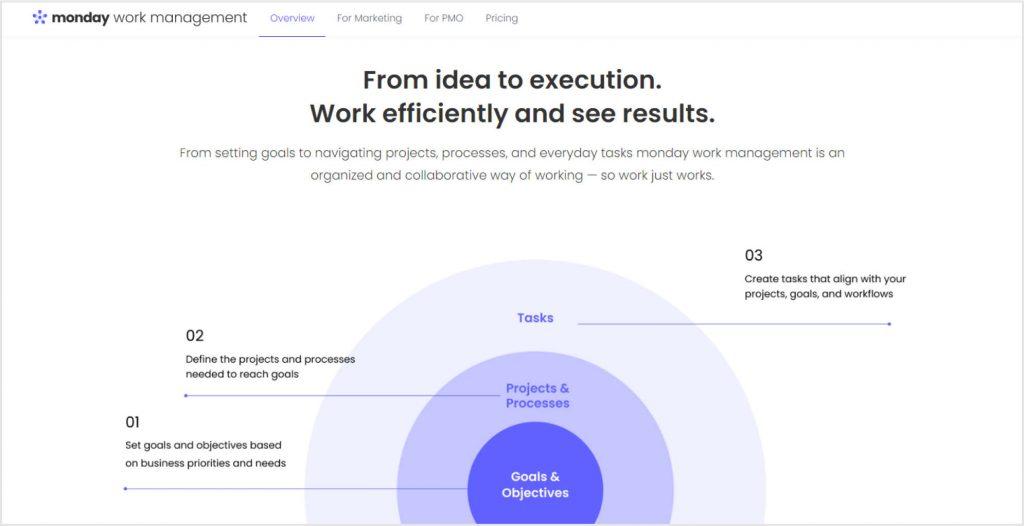
Highlighted Features of monday.com:
- Customizable workflows to adapt to any team’s processes
- Multiple project views: Kanban boards, Gantt charts, timeline, and calendar view
- Automation tools to streamline task and project management
- Time and task tracking for detailed oversight of project timelines
- Advanced reporting dashboards for inclusive monitoring of the projects
- Real-time collaboration with your team members
- Workdocs for collaborative document creation and editing
- Unlimited projects with flexible project planning capabilities
In general, monday.com stands out as one of the best project management tools, offering powerful tools and an intuitive user interface for managing projects of any scale.
To have a deeper level of understanding of monday.com, we recommend you check out this blog: monday.com Review: In-Depth Look at Features, Pros & Pricing.
Get More Done with Less Effort
Our experts help you maximize productivity and streamline workflows with ease.
What is Trello?
Trello is a simple yet highly visual project management tool that helps teams organize and track their work using boards, lists, and cards. It’s well-known for its Kanban board style, which allows users to manage tasks and workflows in a clear, drag-and-drop format.
Trello is especially popular for its ease of use, making it one of the go-to tools for teams managing multiple tasks and smaller project management needs.
Each task is represented as a card that can be moved between lists, assigned to team members, and customized with due dates, checklists, and file attachments.
While Trello excels at basic task management and to-do lists, its free version is limited in high-end features like automation and time tracking.
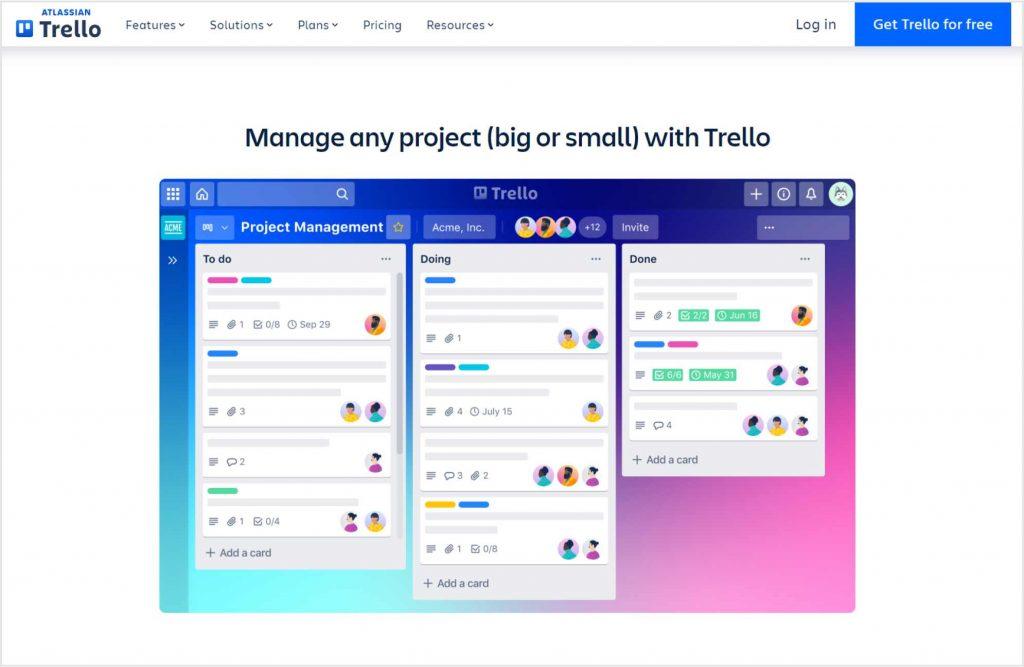
Trello integrates well with other apps but is more suited for teams that prefer simplicity over feature-rich platforms. For more extensive needs, upgrading to paid plans unlocks additional features such as unlimited projects, advanced automation, and project templates.
What is Basecamp?
Basecamp is a straightforward project management tool designed to help teams stay organized and communicate effectively. It combines task management and team communication into one platform, allowing users to manage numerous projects with ease.
Basecamp is known for its simplicity and clean interface, making it easy for teams to create to-do lists, assign tasks, set deadlines, and track progress.
While it is great for teams looking for a simple and streamlined tool, it needs some customization flexibility in other project management tools.
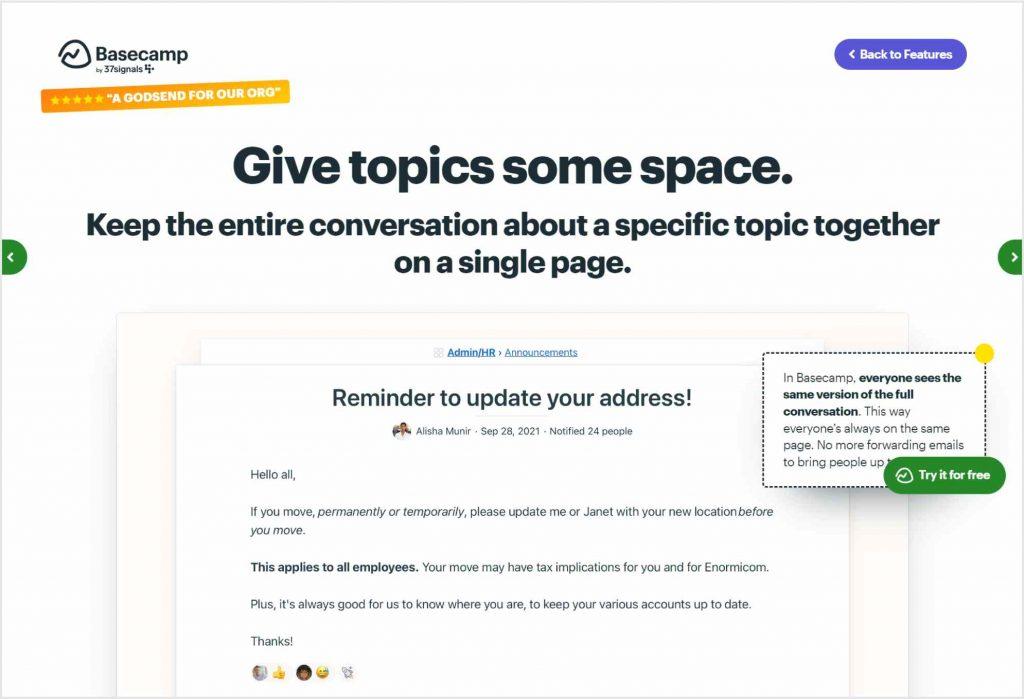
Users have less flexibility compared to other platforms for specific workflows.
In addition, Basecamp’s integrations are somewhat limited, which might restrict teams that rely on third-party tools for more advanced features.
This platform outshines at keeping teams on the same page with features like message boards and group chat, but it may not be the best choice for those managing tough projects or needing highly customizable workflows.
It’s a solid choice for teams seeking an easy-to-use solution for basic project management and collaboration, but it may not meet more demanding needs.
With a solid understanding of what Asana, monday, Trello, and Basecamp bring to the table, it’s time to explore the top essential features that every project manager seeks.
Let’s break down the key features in a glance to see how they stack up against each other:
Top Project Management Tools: Key Features Breakdown
| Features | monday.com | Asana | Trello | Basecamp |
|---|---|---|---|---|
| USP | Highly customizable with multiple views and automation | Advanced task management | Simple Kanban board for task tracking | Centralized communication for teams |
| Integrations | 50+ integrations | 100+ integrations | Limited Integrations | Fewer third-party integrations & built-in tools |
| Automation | ✅ | ✅ | Limited | ❌ |
| Mobile App | iOS and Android | iOS and Android | iOS and Android | iOS and Android |
| Time Tracking | ✅ | ✅ | ❌ | ✅ |
| Collaboration | Cloud-based collaboration, third-party integrations | File sharing, Google Calendar integration | Limited automation | Internal team communication, resource allocation |
| Free Trial | 14-day free trial | 30-day free trial | No free trial | No free trial |
| Pricing | Starts at $12 /month (Standard) | Starts at $10.99 /month (Premium) | Starts at $5 /month (Standard) | Starts at $99/month (for unlimited users) |
| Ratings | 4.7/5 | 4.4/5 | 4.4/5 | 4.1/5 |
| Widely used by | Teams needing customizable workflows and automation | Teams managing complex projects and tasks | Small teams or individuals using Kanban | Teams focused on communication and simple project management |
| Try monday.com For Free |
Having explored the key features of these leading project management tools, let’s closely look into a detailed comparison of Asana, monday.com, Trello, and Basecamp.
Detailed Comparison of Asana, monday, Trello & Basecamp
When analyzing project management tools, the level of customization, Integration capabilities, Automation, Ease of use, and many more factors make all the difference in managing numerous projects.
Let’s survey how Asana, monday.com, Trello, and Basecamp handle to help project managers streamline task management and stay on the same page.
1. Customization
Asana offers a moderate level of customization through its task lists, timelines, and various project views. It’s a flexible project management tool that helps teams assign tasks, set due dates, and manage multiple projects.
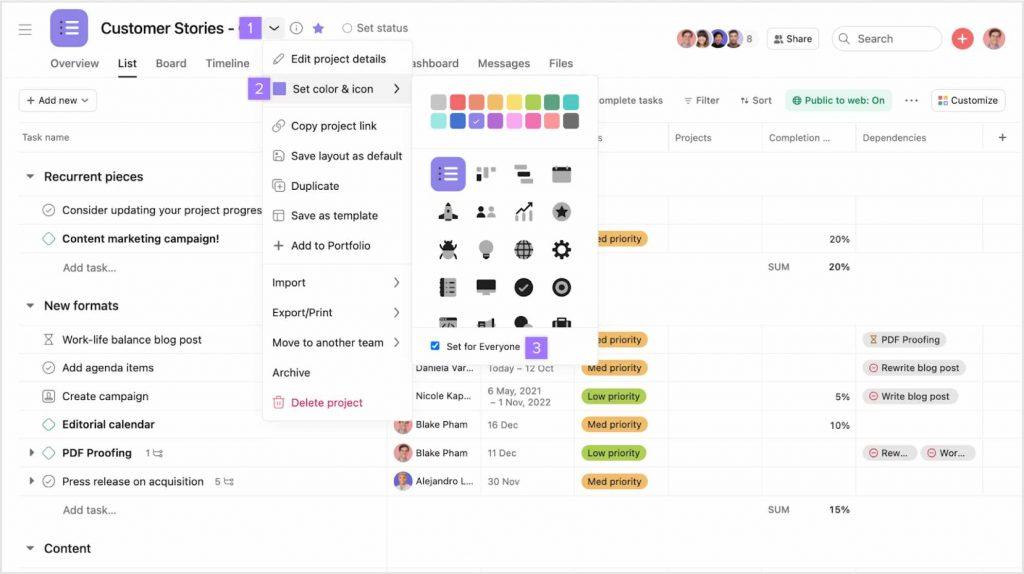
While not as feature-rich as other tools, it’s ideal for handling complicated projects with a simple interface and basic task dependencies.
monday.com distinguishes itself as one of the best customization project management tools. Its highly flexible platform enables users to build custom workflows, track tasks, and integrate with third-party tools.
Additionally, there’s the option for a personalized monday.com integration service for even greater customization.
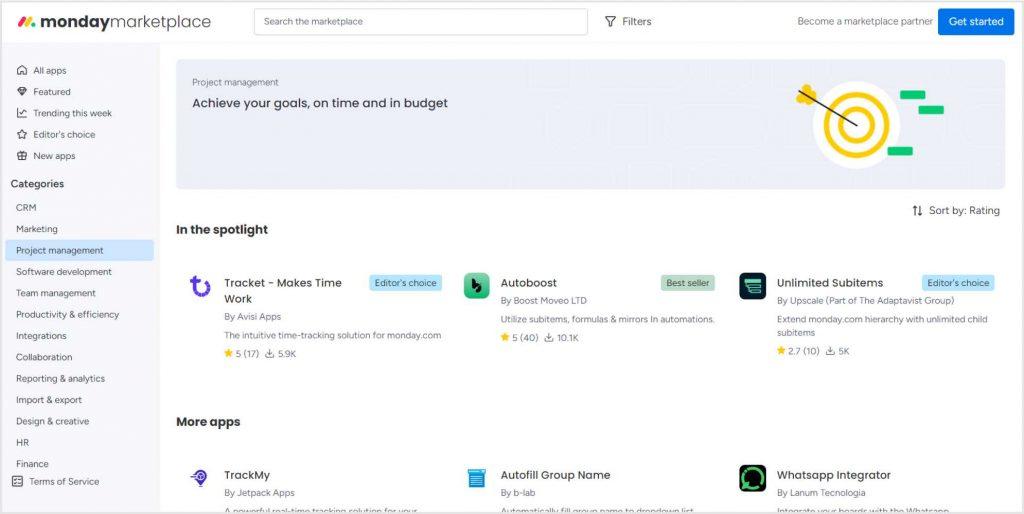
With its automation feature, you can organize projects by setting up personalized boards, columns, and views, such as Kanban boards or Gantt charts.
Even if you’re managing small tasks or an entire project, monday.com’s all-rounded features are perfect for managing simple and clustered projects. It supports unlimited users and provides a free plan for those starting.
Trello keeps things simple with its customizable Kanban board system. You can create boards, add task lists, and manage tasks using cards. Although its intuitive interface allows for easy management of several tasks, its lack of advanced project groundwork features might not suit larger teams needing deeper software project management capabilities.
Basecamp focuses on straightforward collaboration with limited customization options. You can set up to-do lists, create alerts, and track your project’s progress.
While it’s great for internal teams and basic file sharing, Basecamp lacks premium features like task dependencies, automation features, and detailed resource administration, available in other project management software.
2. Integration & Automation
Asana integrates with popular tools to ensure your projects are always in sync. However, its automation is more like a steady bike ride—smooth for everyday use but not built for speed on complex tasks. Basic reminders and notifications get the job done.
monday.com is the true conductor of the automation band. It integrates with a wide range of platforms, and its automation works like a well-oiled machine, reducing manual tasks with seamless workflows.
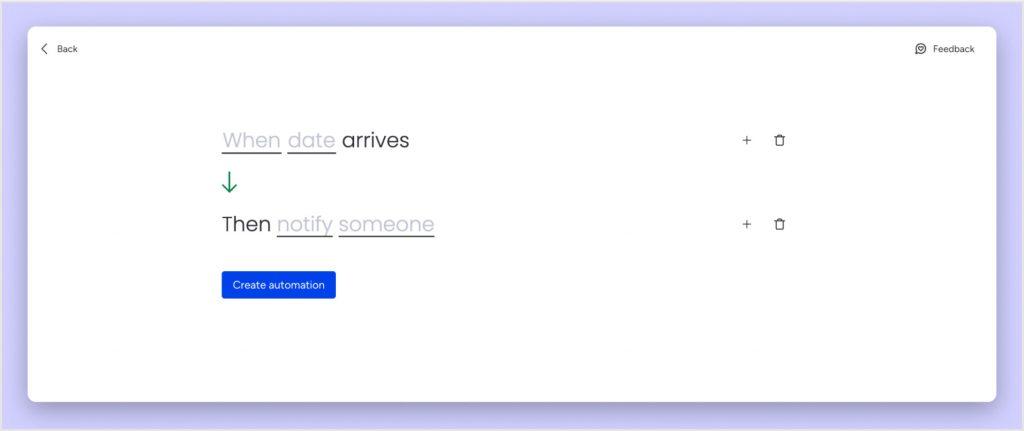
From task updates to complex reminders, monday.com boosts efficiency, helping teams keep multiple projects on track without breaking a sweat. It’s the platform that understands your every need and is always one step ahead, making it the clear front-runner for teams managing large-scale operations.
Trello keeps things simple. With its Trello Power-Ups, you can connect to tools like Slack and Google Calendar. Its automation, powered by Butler, functions like an essential toolkit—good for moving cards around and sending quick notifications but lacking depth for managing more dynamic processes.
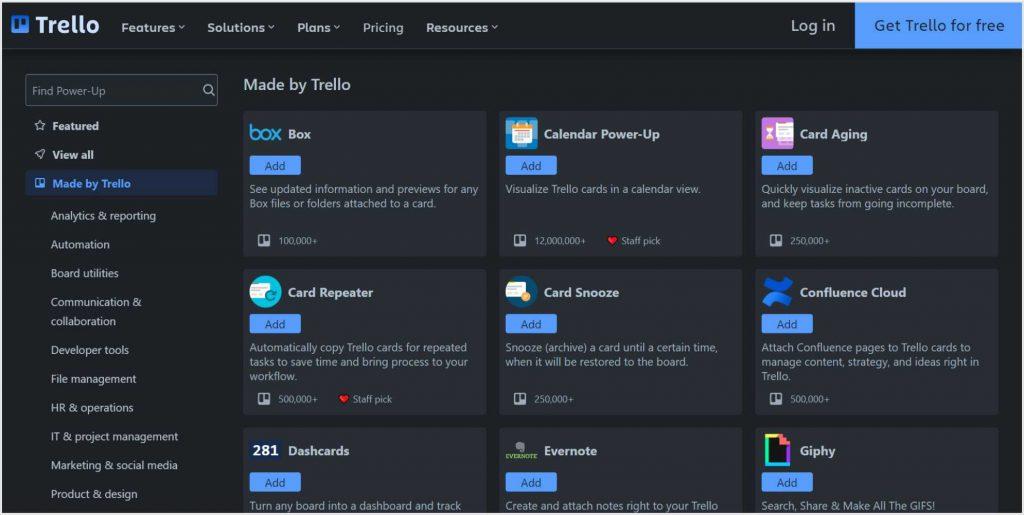
Basecamp is more minimalistic when it comes to integrations and automation. While you can get task reminders and simple to-do list management, it’s more like a quiet assistant—helpful but not proactive in handling complex workflows.
3. Ease of Use
Asana provides a structured yet simple. This platform’s straightforward layout and task dependencies make managing projects manageable without a steep learning curve.
While it offers a range of features, Asana’s ease of use ensures that even those new to project management software can quickly become familiar with it and stay organized.
Hence, Asana is easy to use.
monday.com is most acknowledged for its intuitive interface and easy navigation. It’s designed to simplify project management with a user-friendly dashboard that allows for effortless task management and project tracking.
Its drag-and-drop functionality and customizable boards make creating task lists and organizing projects straightforward. Even if you’re managing tasks, assigning them to team members, or tracking project progress, monday.com’s seamless experience helps keep everyone on the same page, making it a standout choice among project management tools.
Hence, monday.com is the absolute choice for ease of use.
Trello’s Kanban board system is known for its simplicity and visual appeal. The card-based approach allows users to manage tasks and track project progress with minimal effort.
Trello’s user interface is designed for quick task updates and effective collaboration. While it may lack some premium features, its straightforward setup and ease of use make it an excellent tool for organizing projects and tracking tasks, especially for teams that value a visual, intuitive method of project planning.
Hence, Trello is easy to use, especially for beginners.
Basecamp adopts a minimalist approach to project management, which can be refreshing for users who prefer simplicity. Its straightforward interface focuses on essential features like task management and project organization.
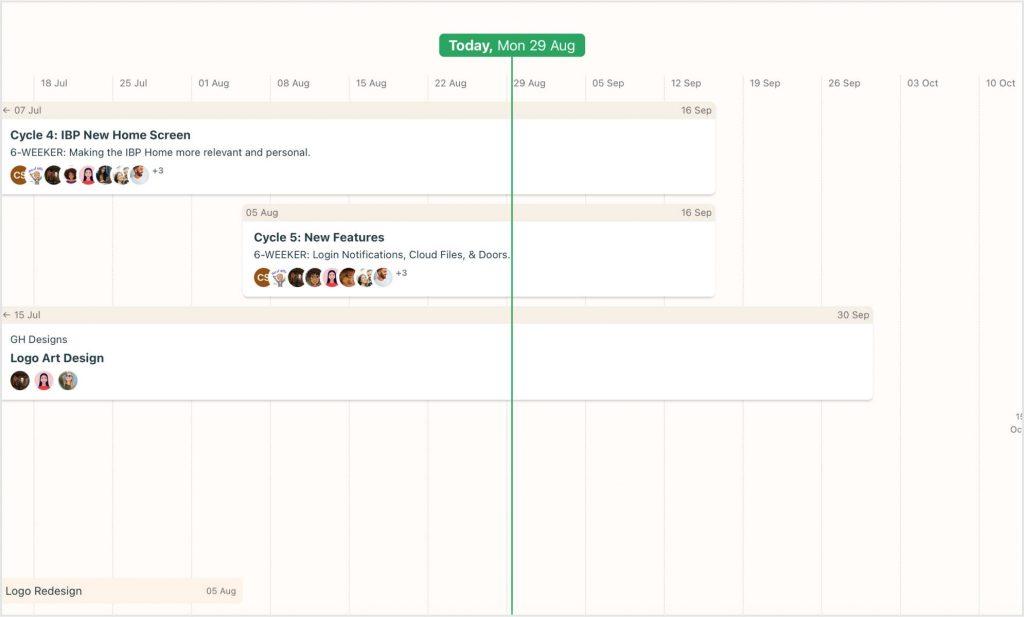
While it may not offer the depth of customization found in other tools, Basecamp’s simplicity ensures that managing projects and coordinating with internal teams is a smooth and hassle-free experience.
Hence, Basecamp is easy to use.
4. Task Management & Tracking
Asana is renowned for its detailed task management and tracking capabilities. Asana’s “Workload” feature allows you to visualize task distribution and adjust assignments based on team availability, helping prevent bottlenecks and ensuring a balanced workload.
monday.com shines bright in task management with its highly customizable boards and advanced tracking features. Beyond basic task assignments and due dates, Monday.com offers an underappreciated feature Workload Management.
It visually represents your team’s workload by aggregating tasks and deadlines comprehensively. Its ability to track and proactively manage team capacity is precious.
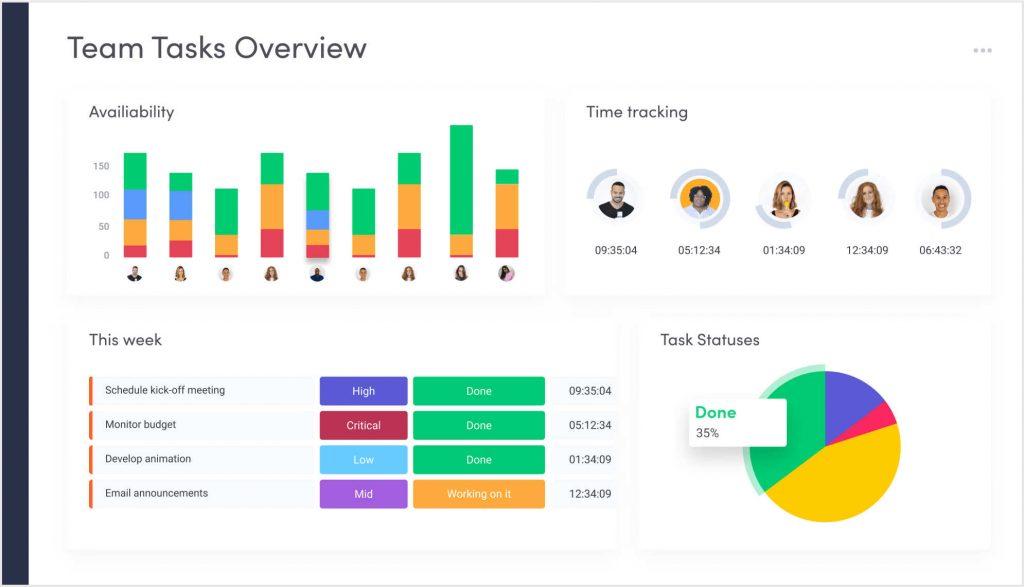
Adjusting timelines and redistributing tasks based on real-time workload data can prevent team members from being overloaded and ensure that projects stay on track.
Additionally, monday.com’s automation and Integration Capabilities allow for seamless updates and notifications, ensuring no task slips through the cracks.
Trello’s card-based system is simple yet versatile. One feature that may not be widely known is its integration with third-party Power-Ups, as mentioned above, which is handy for task tracking.
For example, Power-Ups can enable detailed time tracking and generate custom reports, providing deeper insights into project progress and productivity.
Basecamp takes a modest approach to task management and tracking, emphasizing simplicity and integration. It integrates task management with discussions and file sharing, keeping all relevant project information in one place and streamlining collaboration.
5. Collaboration & Communication
Asana supports collaboration through its task-centric approach. Teams can comment directly on tasks, tag colleagues, and attach files, making it easy to keep all relevant information and discussions in one place.
The platform also offers Project Conversations, which allows teams to engage in broader discussions about project progress, goals, and issues.
monday.com tops in fostering collaboration with its adaptable workspace. The platform integrates communication directly into task management, allowing teams to discuss updates and share files within the same environment.
One standout feature is its collaboration hub, which enables real-time communication and feedback through comments, mentions, and file attachments on tasks and projects.
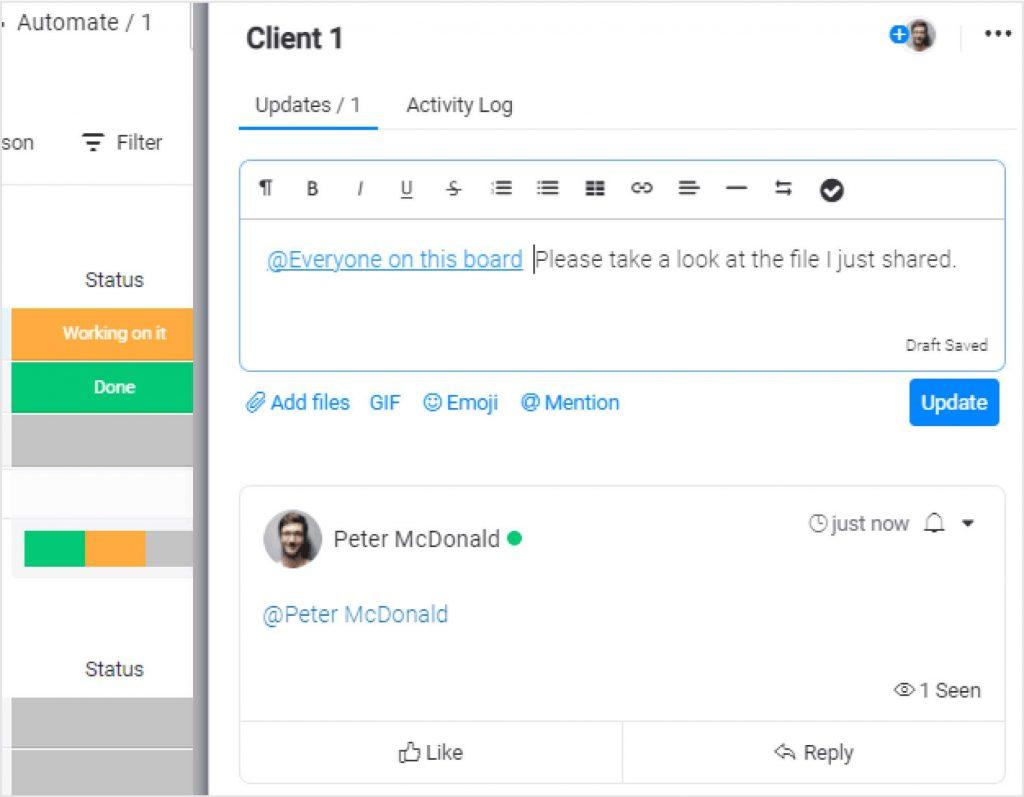
This ensures that team discussions are contextually linked to the relevant work, reducing the need to switch between different tools.
Additionally, monday.com’s automated notifications keep team members informed about project updates and deadlines, enhancing overall communication efficiency.
Trello users can collaborate in its Kanban-style boards, where team members can comment on cards, attach files, and use checklists for task management. Trello’s simplicity ensures that team collaboration remains straightforward, though it may lack some advanced communication features compared to other platforms.
Basecamp is designed with communication at its core. It offers integrated messaging through Campfire chat and group message boards, allowing teams to communicate and collaborate in a centralized space.
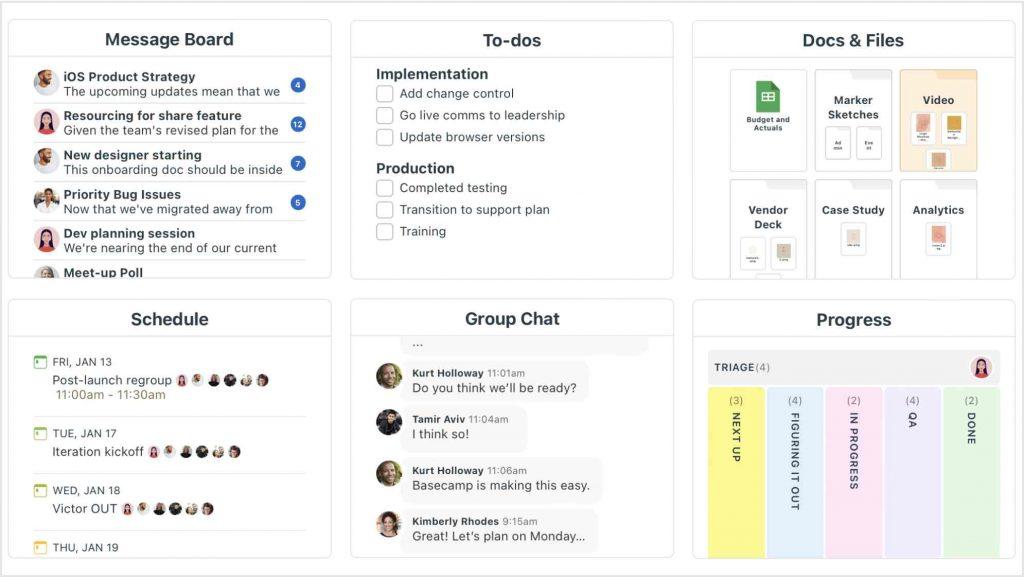
Its to-do lists and message boards organize tasks and discussions, reducing email clutter and ensuring that all project-related communication is accessible and easy to follow. Basecamp’s focus on simplicity and integration makes it a strong choice for teams that value clear, organized communication.
6. Reporting
Asana provides various reporting options, allowing users to create custom dashboards that visualize project progress, task completion, and team workload. Its built-in reporting tools help identify trends and potential roadblocks, making it easier for teams to adjust their strategies as needed.
monday.com heads in reporting, offering a suite of customizable dashboards that empower users to visualize their data in ways that suit their unique workflows. With monday.com, you can track KPIs and project performance through visually appealing graphs and charts, enabling teams to assess their progress at a glance.
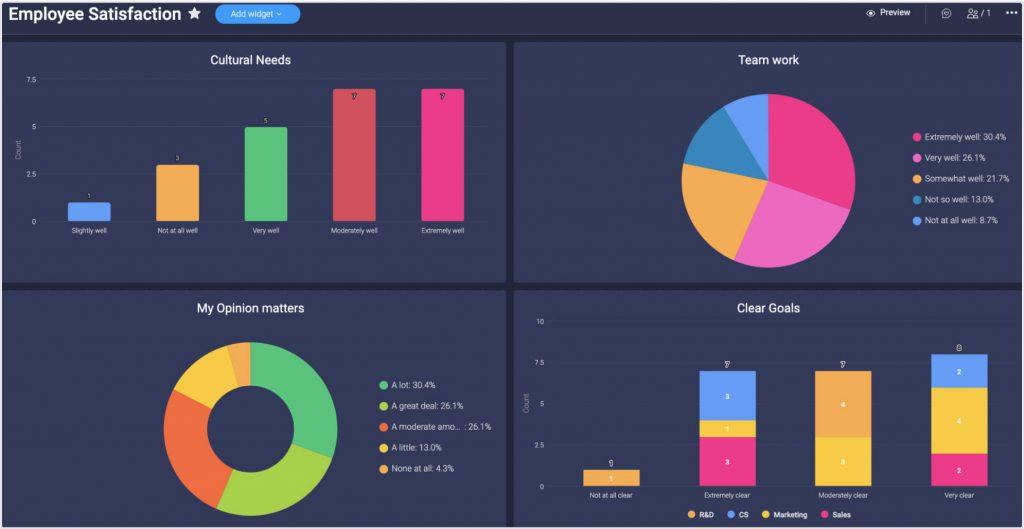
What distinguishes monday.com is its real-time updates and automated reporting features. As projects change, the platform automatically refreshes the data, ensuring that teams are always working with the latest information.
This proactive approach saves time and enhances decision-making, allowing project managers to pivot quickly when challenges arise.
Users can also create detailed reports highlighting team workload, task distribution, and overall project health, making it easier to allocate resources efficiently and keep everyone on the same page.
Trello offers basic reporting capabilities through Power-Ups, enabling users to generate insights on project status and team productivity. While it may not be as comprehensive as other tools, Trello’s simple approach helps teams quickly overview their projects and identify areas for improvement.
Basecamp focuses on straightforward progress tracking with its Hill Charts and automatic check-in reports. These features visually represent project status, helping teams understand where they stand and what needs attention without getting bogged down in excessive data.
In short, reporting is essential in project management tools, providing teams with the insights they need to stay aligned and informed throughout their projects.
Among these options, monday.com stands out as a powerhouse for reporting, offering the flexibility and depth that project managers crave for effective oversight and strategic planning.
After a breakdown of these tools’ features, strengths, and quirks, it is clear that they all have something to offer.
To make decisions easier, look at the pros and cons of Asana, monday.com, Trello, and Basecamp, which help you find the ideal match for your team’s needs!
Pros & Cons of Asana, monday, Trello & Basecamp
| Tool | Pros | Cons |
|---|---|---|
| Asana | – Task Focused Software – Vast options for Integrations – Easy to use | – The built-in time tracking feature is missing – The steeper learning curve for new users – Limited Export and import options – Task Assignment is restricted |
| monday.com | – Flexible Customization – Great Customer Support – Custom Field in all plans – Intuitive User Interface | – Time Tracking is available in pro/paid plans – Onboarding service needs an upgrade |
| Trello | – Instant Real-time update – Kanban System is worthy – Pricing is straightforward | – Lacks premium features – Data Security issues – Hinders scalability – Can be difficult for non-techie user |
| Basecamp | – Easy file-sharing options – To-do list feature is notable – Pro-plan includes all features | – Time tracking feature is not available – Limited reporting feature – Pricing is fixed – Limited integrations |
*If considering monday.com as your project management software, TaskRhino offers a smooth monday.com onboarding service to ensure all queries are solved.
Each platform brings its unique edge in the crowded field of project management tools. Asana simplifies complex workflows, making it the go-to for teams managing intricate projects.
On the other hand, Trello is perfect for those who want a visual, no-fuss way to handle everyday tasks. And if you’re after a clean, communication-focused workspace, Basecamp’s streamlined design keeps things clear and organized.
But monday.com has the limelight – where true flexibility meets scalability.
With powerful automation, endless customization, and smooth collaboration, it adapts and evolves with your team—no matter how big your goals become.
Choosing the right tool can feel overwhelming, but here’s a sharp breakdown of each platform’s standout strengths to help you find the perfect fit for your team’s needs,especially if you’re considering Asana alternatives.
Which Project Management Tool is suitable for you?
| Asana | Best for handling sophisticated workflows with ease |
| monday.com | The ultimate choice for teams needing customization and scalability |
| Trello | Perfect for simple and visual task arrangement |
| Basecamp | Ideal for teams with a communication-first approach |
Expert monday.com Consulting Services
Guiding Your monday.com Journey from implementation, training, support, and more…
Frequently Asked Questions
What is better, Trello or Asana or monday?
Choosing the best tool depends on your team’s needs. Trello works well for smaller teams handling simpler tasks thanks to its easy-to-use Kanban boards. However, as projects grow, Trello can feel limiting. With its advanced task management and tracking features, Asana is better for managing complex projects and larger teams.
monday.com, however, offers customizable workflows and powerful automation, making it ideal for handling multiple projects. Its flexibility allows teams to design workflows to suit specific needs. Ultimately, it comes down to whether you need simplicity (Trello), detailed task management (Asana), or customization and automation (monday.com).
Is Basecamp better than Asana?
Basecamp focuses on communication, making it a solid choice for teams that need a simple platform for discussions and file sharing. Asana is stronger regarding task management, especially for larger teams or complex workflows. Asana is the better option if you prioritize streamlining task tracking and dependencies. If you need a tool that simplifies communication, Basecamp might better suit your team’s needs
Why is Asana so expensive?
Asana’s pricing reflects its advanced features like task dependencies, workflow automation, and time tracking. These tools help streamline complex projects, making the platform worth the cost for larger teams. The price covers the ability to manage projects efficiently with more advanced functionality.
How to migrate data from Trello to monday?
You can easily import data from Trello to monday.com via third-party tools such as Zapier, etc., or use the monday.com Data Migration Service for complex or large projects.
Is Basecamp similar to monday?
No, Basecamp is more straightforward and focused on communication, while monday.com offers customizable project management workflows and automation for complex needs.
What are the disadvantages of Trello?
Trello has several limitations, such as lacking advanced features like time tracking and reporting. It can become cluttered with large projects, doesn’t offer task dependencies, and has limited customization options. Additionally, many useful features require paid Power-Ups, adding to the cost.
Editor's Choice
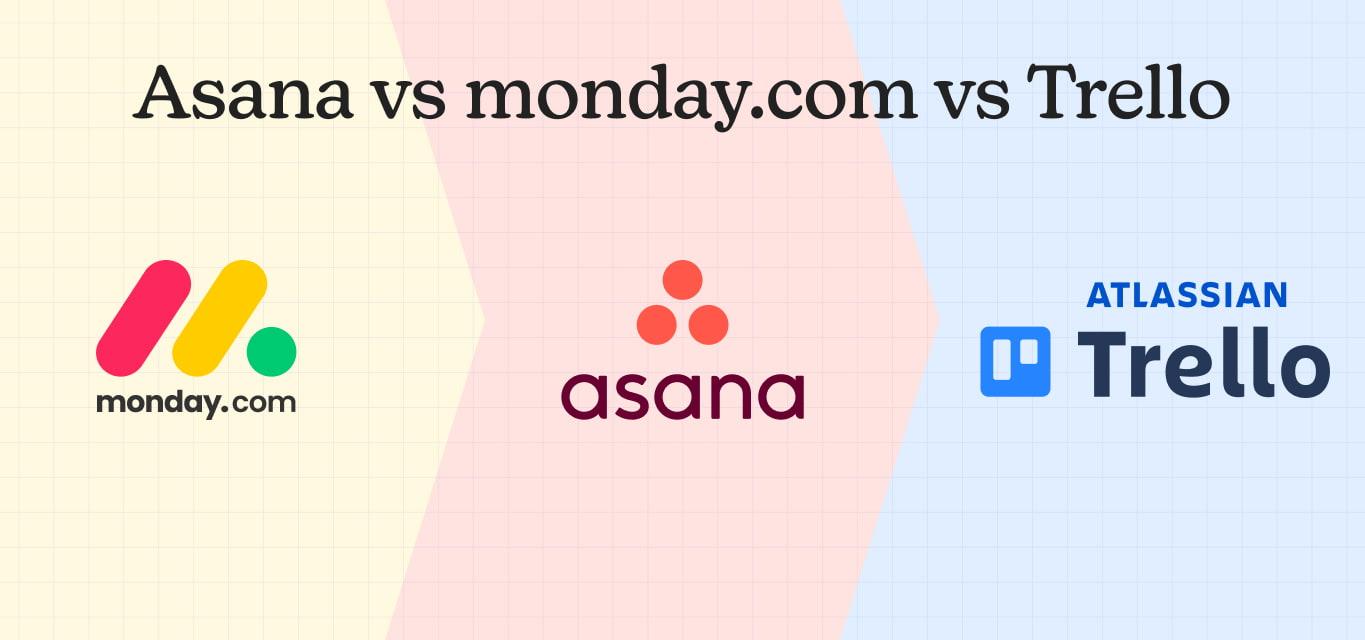
Asana vs monday vs Trello: Complete Comparison Guide 2025
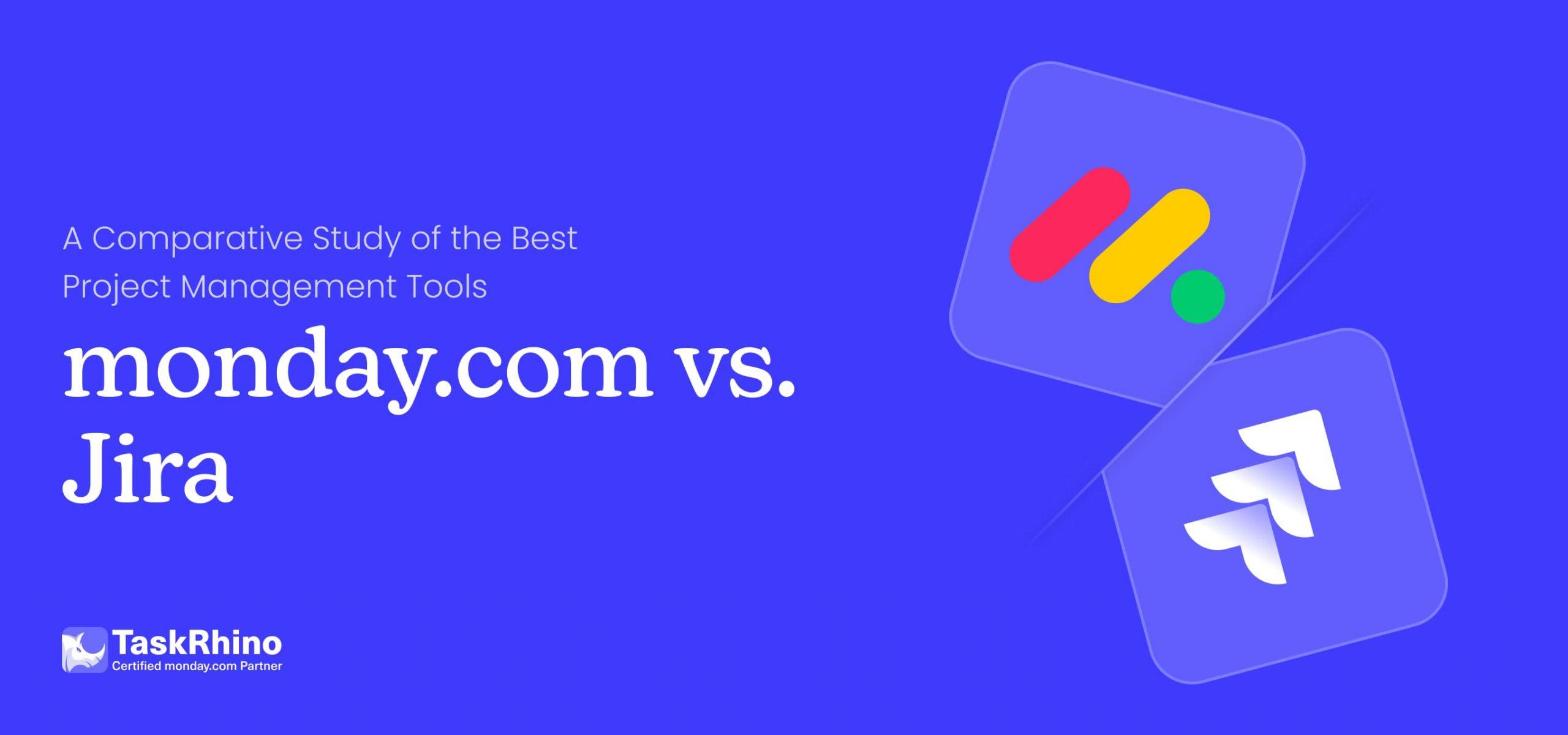
monday vs Jira 2025: Complete Feature Comparison & Decision Guide
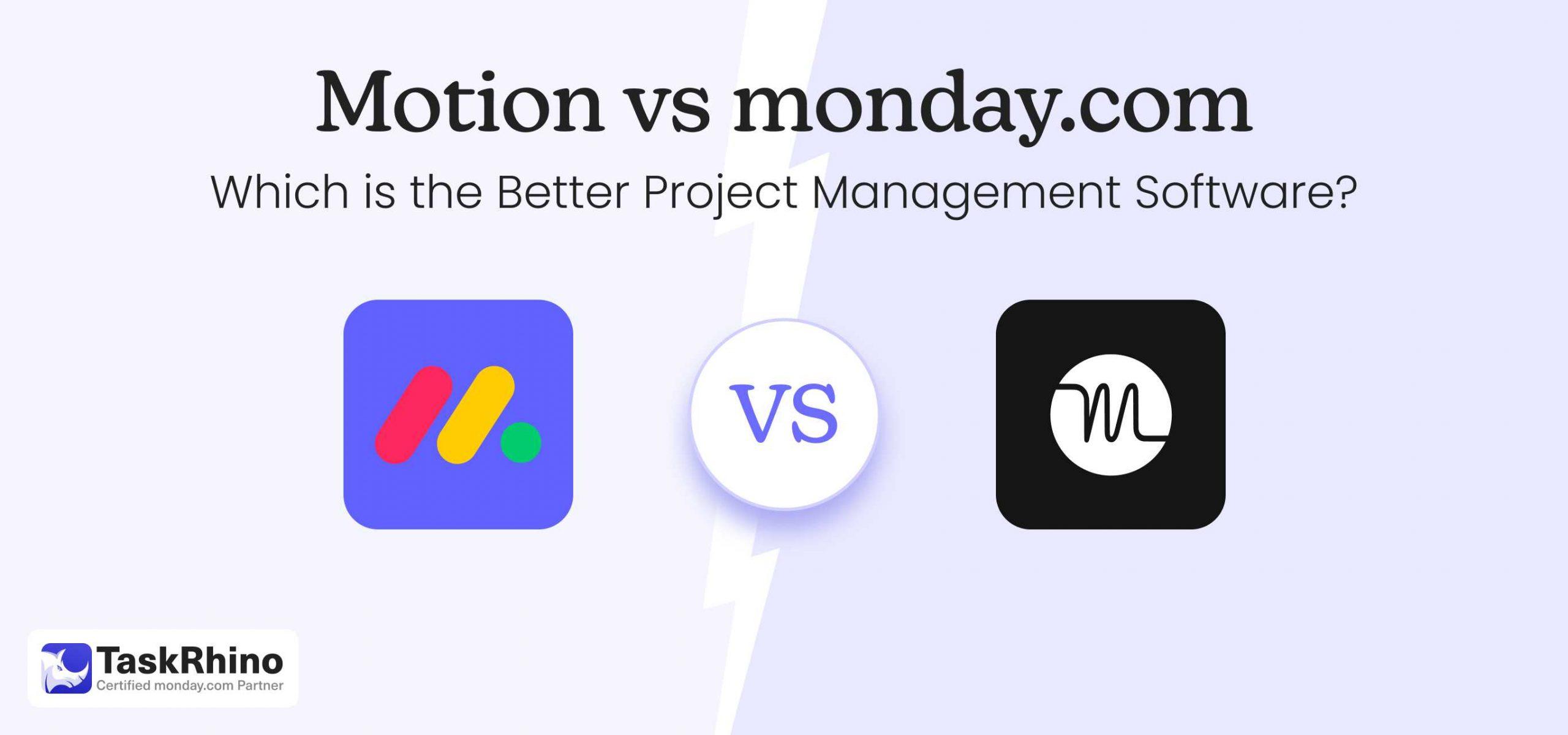
Motion vs monday.com: Complete Comparison Guide 2025
